Brain Meltdown Recovery Program
Dude what’s with the title? Simply this, six years ago I had a brain meltdown, I mean I just went stupid. It was one of those rash and impulsive moments, where your brain seems to be in a haze, ever get that feeling? Anyway in one of those moments I just went and sold six prime Nikon lenses. Adding to the insult was the fact that I sold them for far less then they were worth. There is no need to list these lenses, suffice to say they were all hand picked for their reputations as some of Nikon’s finest glass. They were AI manual focus, all metal and glass “old school”.
At the time I was mostly using two zooms. A 17-35 mm and a 80-200 mm for my work. Both fine lenses. In addition to the two zooms, I kept two macro lenses and two telephotos. Maybe I thought I was “downsizing” or something like that. Anyway for a time I was quite content with what I had kept. Then one day the 17-35 went down, and I was without another wide angle for backup, until the lens could be repaired. Later on I added another zoom, the 12-24 mm. It was about this time when I realized the enormity of the mistake I had made.
Now begins the recovery or replacement period. The first “recovery” lens that I have chosen is the 85 mm f 1.4 AF-D. The following review as I have stated before will be my personal observations and feelings and not really a technical report. That I will leave to others who are far more qualified.
Complaints & Issues
First thing is to address some issues and complaints about this particular instrument that have appeared in other reviews. The lens hood! It is metal and of a screw-in variety. Some find it a problem, thus far I have not. Especially in consideration to already having replaced several of the resin bayonet ones from my other lenses and of course the plastic rear lens covers. They are convenient as you can reverse them on the lens, but they just wear out in time, whereas the metal one on the 85, looks like it will be around for some time. Possibly Nikon or a third party could come up with a rubber one, that would help alleviate the problem for those who do find it objectionable. Similar to the ones that you can get for the 50 mm f 1.4 & 1.8. Where they fold down into a donut shape and one can leave them on (with lens cap). My 85 is kept in a soft pouch that is large enough to keep the lens hood fixed in place. Though most of the time it is on one of my cameras.
Auto Focus
Auto focus. An AF-S version would be preferable for a number of reasons. Like my 80-200 mm, the 85 exhibits the same sort of “hunting” problem under strong backlit conditions. Which can be irritating to say the least, though I have experienced the same problem with the silent wave models. The noise is another problem some have complained about. Though I don’t find it an issue. Focusing speed is another problem some have complained about. For the most part I have found the lens to focus fast enough with my now ancient D2X. It even performes well in very low light situations. I am curious to see how fast it will focus on the D3. My only real gripe about the AF is the A M switch. It is difficult at best. I much prefer the AF-S versions for the manual over ride feature without having to change switches and push buttons. Because of the large aperture size and subsequent brightness, manual focus is made easy and quick. The focus ring is large and has a nice rubber textured grip and the action on my model is very smooth.
Build Quality and Performance
A friend had asked me why I didn’t get the 1.8 /85 mm. Two reasons. Let me first say something about the build quality. No matter what you read, this lens is a beautiful precision piece of equipment and until you actually have one in your hand, you can’t fully appreciate the superlatives that have been heaped upon it. At around 20 ounces (550 grams) it has a nice hefty and solid feel. The finish is all metal and glass and has a crinkle finish, no plastic to be found. This lens is really reminiscence of that “old school” look and feel. Even if the performance wasn’t so good, it would still be a joy just to handle. The front of the lens is 77 mm and thus maintains the Nikon pro-line size, and also adds to the classic look.
Of course more important to the look of the lens, is the look of the images that the lens is capable of producing. Here again this lens does not disappoint. The sharpness is there in spades. However it is the transition between the sharp area and the out-of-focus areas, where this lens really shines. It is because of the out-of-focus area or bokeh that this lens has been called the “cream machine”. It can truly render the out-of-focus areas with a very creamy texture. This is the main reason I went for this lens to be my first new prime for my wedding and portrait work. The 1.8 / 85 mm, is for the most part plastic and it’s bokeh is no where near as “creamy”.
As for performance, at 1.4 I am a bit disappointed with the results. Lower contrast, pronounced CA’s in high contrast areas (which is easily fixed in post) and seems a little soft, though at the same time it exhibits a kind of “dreamy” look. However at 2.0 and beyond it is nothing short of wonderful. If I remember my physics class, almost all lenses are at their best two stops from either end of their aperture range. So I am very happy to have such excellent results from 2.0 and on. Even at 1.4 it still produces usable and sometimes rather pleasing images.
Focus Shift
Now for some examples. Though I stated before this was not to be a technical report, I have done some testing on one issue. Focus shift. I set up my camera and lens at approximately a 45 degree angle with the # 5 on the ruler one meter from the front lens. Mirror lock-up and a cable release were used. I shot in both auto and manual focus modes and got identical results. There is of course the possibility of the camera having moved (ever so slightly) when the aperture setting was changed. The more accurate way would be to use Nikon Camera Control and operate from a computer via a wifi set-up.
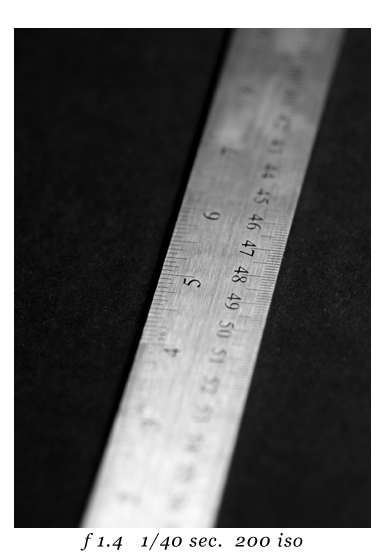
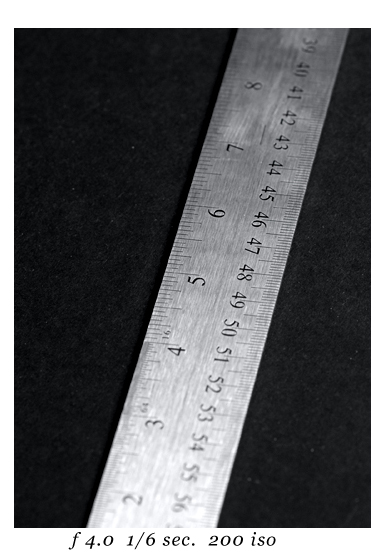
From the original image, I zoomed in to 400% and it appears that I focused just right where I wanted on the front edge of #5. As you can see the DOF isn’t much at this distance.
My number one assistant, who also happens to be my daughter and is always eager to help me out, helped a lot on this report. Of course there was some compensation involved, as I had to put Shrek on for the 79th or so time. The next two shots show the difference between 1.4 & 2.0. All of her photos were shot at ISO 640 & 800 and in some cases really difficult lighting conditions. A D2X was used, which is known not to be very good at higher ISO’s. Despite having these handicaps, I feel the quality of the lens shines through.
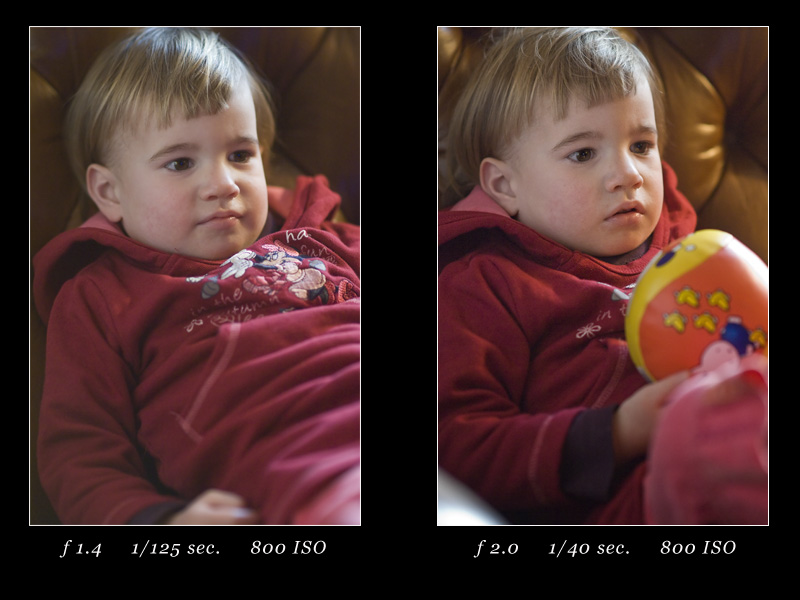
Here are more examples:

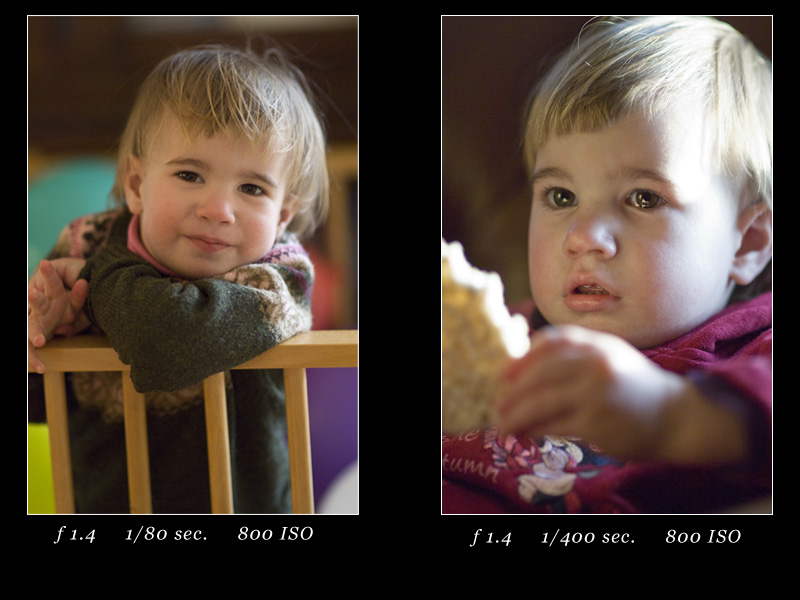
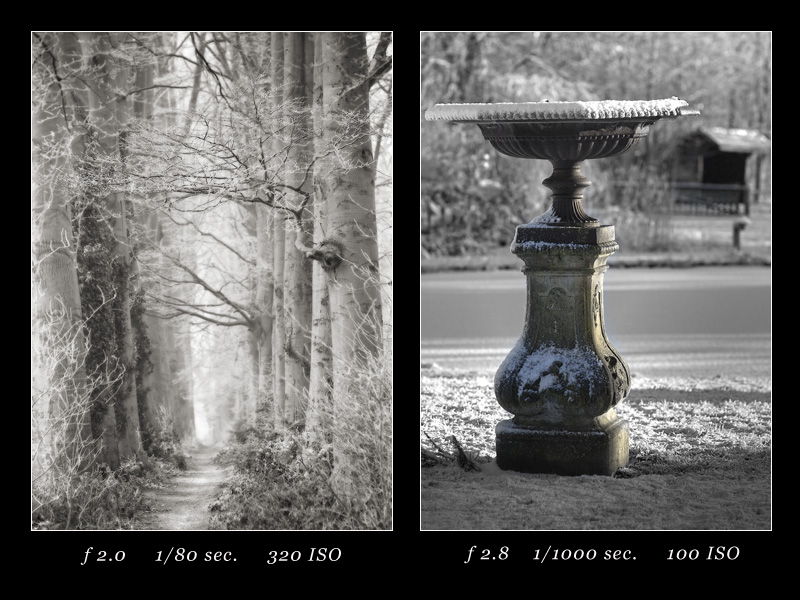
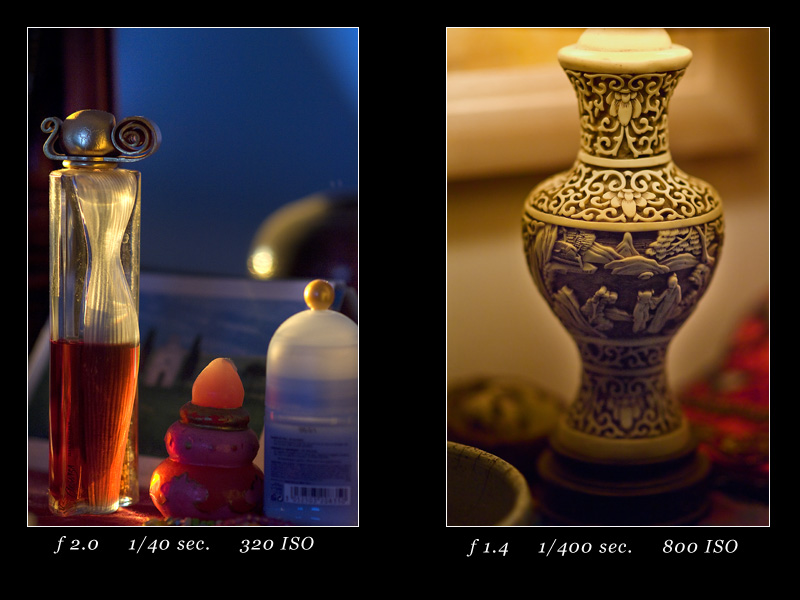
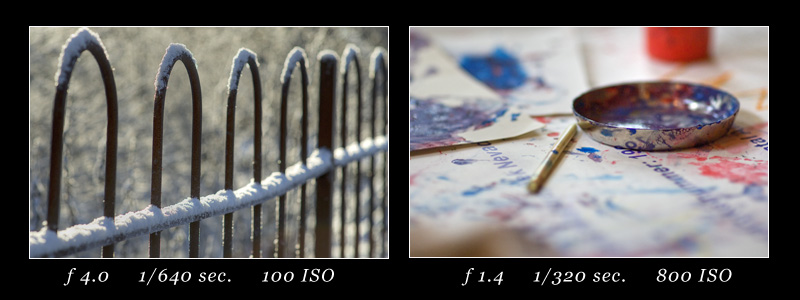
Conclusion
Plain and simple, I like this lens. It isn’t perfect, but it has a character or if you prefer it’s own personality. As you can see it performs well under trying conditions. At the time I was researching the lens, I must admit I was undecided for awhile over the Nikon and the Zeiss 85 mm f 1.4. In the end, having a lens with AF seemed the better choice. Since the AF on the Nikon works so well (albeit with a few issues) I am glad of my decision. From the perspectives of a fast lens with AF and one capable of artistry, this lens is a must have. If I end up only getting one prime, I will be quite happy it is this lens. Though of course I do have my eyes on a few others, we’ll see what the future brings.
